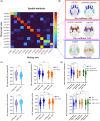Brain activation and connection across resting and motor-task states in patients with generalized tonic-clonic seizures
- PMID: 38644561
- PMCID: PMC11033329
- DOI: 10.1111/cns.14672
Brain activation and connection across resting and motor-task states in patients with generalized tonic-clonic seizures
Erratum in
-
Correction to Brain activation and connection across resting and motor task states in patients with generalized tonic-clonic seizures.CNS Neurosci Ther. 2024 Jun;30(6):e14790. doi: 10.1111/cns.14790. CNS Neurosci Ther. 2024. PMID: 38828736 Free PMC article. No abstract available.
Abstract
Aims: Motor abnormalities have been identified as one common symptom in patients with generalized tonic-clonic seizures (GTCS) inspiring us to explore the disease in a motor execution condition, which might provide novel insight into the pathomechanism.
Methods: Resting-state and motor-task fMRI data were collected from 50 patients with GTCS, including 18 patients newly diagnosed without antiepileptic drugs (ND_GTCS) and 32 patients receiving antiepileptic drugs (AEDs_GTCS). Motor activation and its association with head motion and cerebral gradients were assessed. Whole-brain network connectivity across resting and motor states was further calculated and compared between groups.
Results: All patients showed over-activation in the postcentral gyrus and the ND_GTCS showed decreased activation in putamen. Specifically, activation maps of ND_GTCS showed an abnormal correlation with head motion and cerebral gradient. Moreover, we detected altered functional network connectivity in patients within states and across resting and motor states by using repeated-measures analysis of variance. Patients did not show abnormal connectivity in the resting state, while distributed abnormal connectivity in the motor-task state. Decreased across-state network connectivity was also found in all patients.
Conclusion: Convergent findings suggested the over-response of activation and connection of the brain to motor execution in GTCS, providing new clues to uncover motor susceptibility underlying the disease.
Keywords: activation; fMRI; generalized tonic–clonic seizures; motor‐task state; network connectivity; resting state; white matter.
© 2024 The Authors. CNS Neuroscience & Therapeutics published by John Wiley & Sons Ltd.
Conflict of interest statement
The authors report no competing interests.
Figures





Similar articles
-
Dynamic functional network connectivity in idiopathic generalized epilepsy with generalized tonic-clonic seizure.Hum Brain Mapp. 2017 Feb;38(2):957-973. doi: 10.1002/hbm.23430. Epub 2016 Oct 11. Hum Brain Mapp. 2017. PMID: 27726245 Free PMC article.
-
Altered dynamic functional network connectivity within default mode network of epileptic children with generalized tonic-clonic seizures.Epilepsy Res. 2022 Aug;184:106969. doi: 10.1016/j.eplepsyres.2022.106969. Epub 2022 Jun 18. Epilepsy Res. 2022. PMID: 35738202
-
Altered temporal dynamics of brain activity in patients with generalized tonic-clonic seizures.PLoS One. 2019 Jul 17;14(7):e0219904. doi: 10.1371/journal.pone.0219904. eCollection 2019. PLoS One. 2019. PMID: 31314786 Free PMC article.
-
Functional and structural connective disturbance of the primary and default network in patients with generalized tonic-clonic seizures.Epilepsy Res. 2021 Aug;174:106595. doi: 10.1016/j.eplepsyres.2021.106595. Epub 2021 Feb 25. Epilepsy Res. 2021. PMID: 33993017
-
Pharmacotherapy for tonic-clonic seizures.Expert Opin Pharmacother. 2014 Jul;15(10):1417-26. doi: 10.1517/14656566.2014.915029. Epub 2014 May 6. Expert Opin Pharmacother. 2014. PMID: 24798217 Review.
Cited by
-
Normative structural connectome constrains spreading transient brain activity in generalized epilepsy.BMC Med. 2025 May 2;23(1):258. doi: 10.1186/s12916-025-04099-7. BMC Med. 2025. PMID: 40317018 Free PMC article.
References
-
- Fisher RS, Cross JH, French JA, et al. Operational classification of seizure types by the international league against epilepsy: position paper of the ILAE Commission for Classification and Terminology. Epilepsia. 2017;58(4):522‐530. - PubMed
-
- Camfield P, Camfield C. Idiopathic generalized epilepsy with generalized tonic‐clonic seizures (IGE‐GTC): a population‐based cohort with >20 year follow up for medical and social outcome. Epilepsy Behav. 2010;18(1–2):61‐63. - PubMed
-
- Seneviratne U, Cook M, D'Souza W. The prognosis of idiopathic generalized epilepsy. Epilepsia. 2012;53(12):2079‐2090. - PubMed
-
- Badawy RAB, Curatolo JM, Newton M, Berkovic SF, Macdonell RAL. Changes in cortical excitability differentiate generalized and focal epilepsy. Ann Neurol. 2007;61(4):324‐331. - PubMed
Publication types
MeSH terms
Substances
Grants and funding
LinkOut - more resources
Full Text Sources
Medical

